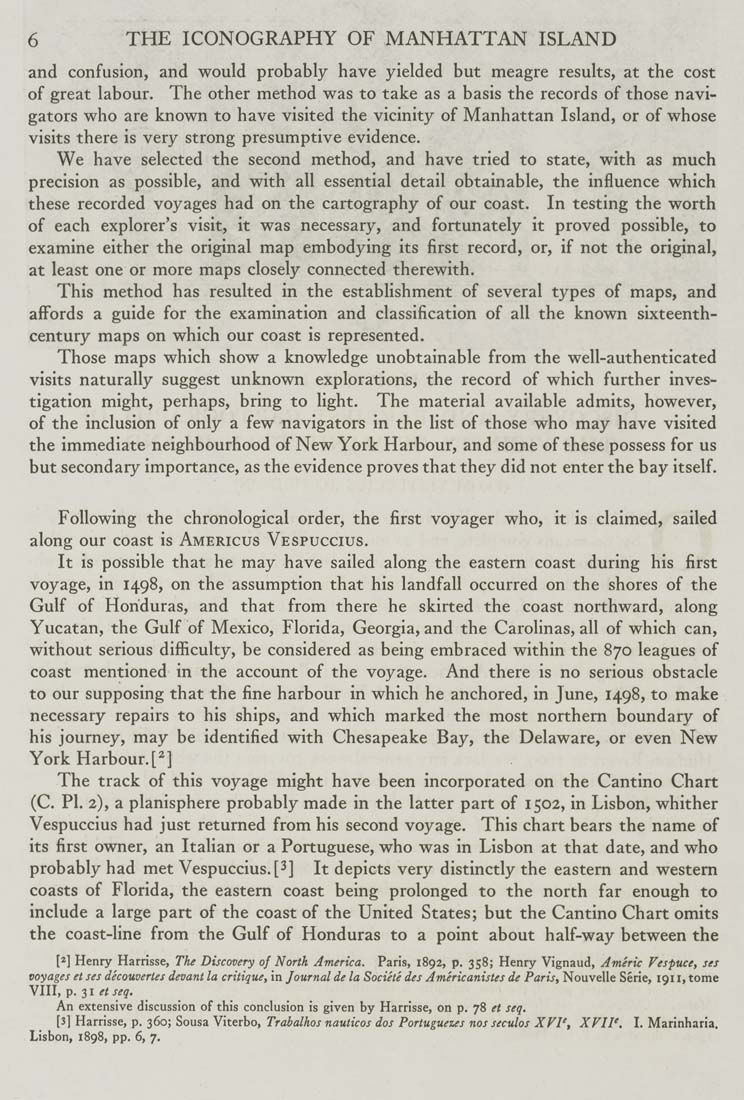6 THE ICONOGRAPHY OF MANHATTAN ISLAND
and confusion, and would probably have yielded but meagre results, at the cost
of great labour. The other method was to take as a basis the records of those navi¬
gators who are known to have visited the vicinity of Manhattan Island, or of whose
visits there is very strong presumptive evidence.
We have selected the second method, and have tried to state, with as much
precision as possible, and with all essential detail obtainable, the influence which
these recorded voyages had on the cartography of our coast. In testing the worth
of each explorer's visit, it was necessary, and fortunately it proved possible, to
examine either the original map embodying its first record, or, If not the original,
at least one or more maps closely connected therewith.
This method has resulted In the establishment of several types of maps, and
affords a guide for the examination and classification of all the known sixteenth-
century maps on which our coast Is represented.
Those maps which show a knowledge unobtainable from the well-authenticated
visits naturally suggest unknown explorations, the record of which further inves¬
tigation might, perhaps, bring to light. The material available admits, however,
of the inclusion of only a few navigators in the list of those who may have visited
the immediate neighbourhood of New York Harbour, and some of these possess for us
but secondary importance, as the evidence proves that they did not enter the bay itself.
Following the chronological order, the first voyager who, it Is claimed, sailed
along our coast Is Americus Vespuccius.
It Is possible that he may have sailed along the eastern coast during his first
voyage, in 1498, on the assumption that his landfall occurred on the shores of the
Gulf of Honduras, and that from there he skirted the coast northward, along
Yucatan, the Gulf of Mexico, Florida, Georgia, and the Carolinas, all of which can,
without serious difficulty, be considered as being embraced within the 870 leagues of
coast mentioned in the account of the voyage. And there is no serious obstacle
to our supposing that the fine harbour in which he anchored, in June, 1498, to make
necessary repairs to his ships, and which marked the most northern boundary of
his journey, may be identified with Chesapeake Bay, the Delaware, or even New
York Harbour.[^]
The track of this voyage might have been incorporated on the Cantino Chart
(C. PI. 2), a planisphere probably made In the latter part of 1502, in Lisbon, whither
Vespuccius had just returned from his second voyage. This chart bears the name of
its first owner, an Italian or a Portuguese, who was In Lisbon at that date, and who
probably had met Vespuccius. [3] It depicts very distinctly the eastern and westem
coasts of Florida, the eastern coast being prolonged to the north far enough to
include a large part of the coast of the United States; but the Cantino Chart omits
the coast-line from the Gulf of Honduras to a point about half-way between the
[2] Henry Harrisse, The Discovery of North America. Paris, 1892, p. 358; Henry Vignaud, Americ Fespuce, ses
voyages et ses decouvertes devant la critique, in Journal de la Societe des Americanistes de Paris, Nouvelle Serle, 1911, tome
VIII, p. 31 etseq.
An extensive discussion of this conclusion is given by Harrisse, on p. 78 et seq.
[i\ Harrisse, p. 360; Sousa Viterbo, Trabalhos nauticos dos Poriuguezes nos seculos XFI', XVII'. I. Marinharia.
Lisbon, 1898, pp. 6, 7.
|








